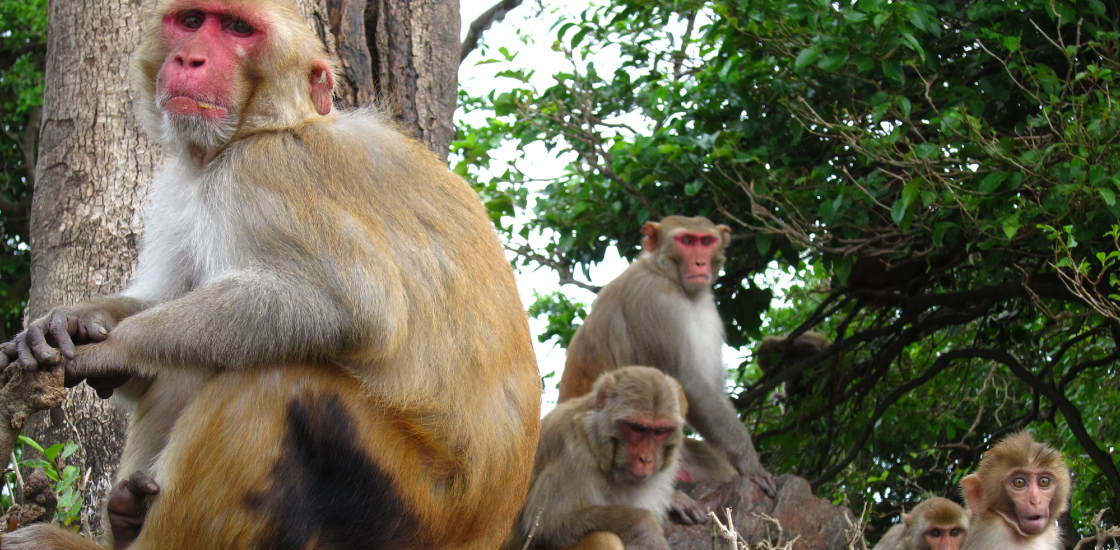
Photo by Lauren Brent
THIS ARTICLE IS MORE THAN FIVE YEARS OLD
This article is more than five years old. Autism research — and science in general — is constantly evolving, so older articles may contain information or theories that have been reevaluated since their original publication date.
On an island off the coast of Puerto Rico, about 1,500 monkeys roam and breed freely, undisturbed by the few scientists observing them at a distance. This natural colony affords researchers a rare opportunity to trace how genetic variation affects complex social behaviors in the wild.
What they have found so far suggests that roughly one-sixth of the monkeys in the colony carry a variant in SHANK3, a top autism gene candidate that is mutated in about 1 percent of people with autism. The monkeys with the variant are more likely than others to mingle with different social groups that don’t usually intersect. Researchers presented the preliminary results yesterday at the 2015 Society for Neuroscience annual meeting in Chicago.
“With lab models, you can do great genetic manipulation, but you’re working with mice and flies, whose social lives are not like humans,” says Seth Madlon-Kay, a graduate student in Michael Platt’s lab at Duke University in Durham, North Carolina, who presented the findings.
The researchers have sequenced the genomes of some of the monkeys, and are working to sequence the rest. To link genetics to behavior, they are collecting detailed information on each monkey by observing a single animal for 10 minutes at a stretch. The scientists record behaviors from grunts to mating and note which monkeys interact with which other ones.
The researchers are also designing quicker experiments, such as documenting a monkey’s reaction when a scientist jumps out of a bush holding a picture of another monkey. This may sound “kooky,” says lead investigator Platt, but the goal is to compare the results of experiments that can be done in the laboratory with the wealth of natural data the researchers have for each animal.
High-stakes environment:
SHANK3 codes for a protein that helps bolster synapses, the connections between neurons. Deletion of a larger region that includes SHANK3 leads to Phelan-McDermid syndrome, a severe developmental disorder characterized by intellectual disability and seizures.
For the study, the researchers sequenced one segment of the SHANK3 gene, called exon21, the landing site for many of the mutations seen in people with autism.
Of 240 monkeys for which they have sequence information, 200 carry the sequence most commonly seen in people and in mice. Another 40 have a variant that alters one amino acid in the corresponding protein, which computer algorithms predict would harm the protein’s structure. Researchers have not seen this variant in people.
All 40 of the monkeys carry the mutation on only one chromosome. Also, the variant is spread evenly among the groups of monkeys on the island, suggesting that it does not confer any particular survival advantage or disadvantage.
Yet it seems to influence their behavior. Charting the social ties between monkeys, the researchers can determine how connected a monkey is to its neighbors. They can also measure the extent to which a monkey’s ‘friends’ interact with each other. A monkey that acts as a hub between other monkeys that do not interact much is considered to have high ‘betweenness.’
So far the monkeys with the variant have higher ‘betweenness’ scores than those with normal SHANK3, suggesting that they socialize with monkeys that don’t know each other.
“It’s in the opposite direction than you might expect intuitively. In humans if this variant was causing autism-like effects, you might expect less sociality,” says Madlon-Kay.
The explanation may lie in the monkey variant itself. Unlike mutations seen in people, which mostly destroy the SHANK3 protein’s activity, this variant might boost SHANK3’s activity, says Martien Kas, associate professor of translational research at Utrecht University in the Netherlands, who was not involved in the study.
Mutations that lead to severe effects like those seen in people would be unlikely to be present in the “highly competitive” monkey social groups, says Madlon-Kay. “Because it’s a natural population, the animals live and die on their own merits. Any monkey with a super-high-impact mutation is probably going to die,” he says.
But researchers can track the effects of mild variants that may lead to subtle changes in social behavior. They can also investigate the collective effects of more than one variant.
“In the future we’re trying to move away from looking at each individual variant by itself, and looking instead at aggregating across many different common variants,” says Madlon-Kay. “We can see what sort of impact they actually have in a high-stakes social environment.”
For more reports from the 2015 Society for Neuroscience annual meeting, please click here.
By joining the discussion, you agree to our privacy policy.